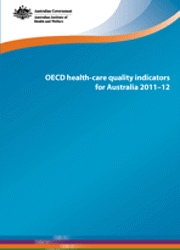Summary
This report:
- summarises information Australia provided in 2013 to the Organisation for Economic Co-operation and Development's (OECD) Health Care Quality Indicators (HCQI) 2012-13 data collection
- compares data supplied by Australia in 2013 to data Australia supplied in previous years, and to data reported by other OECD countries in the OECD's Health at a glance 2013: OECD indicators, or HAAG 2013 (OECD 2013a).
Australia's contribution to the HCQI project is part of its multifaceted effort to maintain and improve the safety and quality of health-care services in Australia.
International data comparisons present many challenges due to the differences in data collection practices and data quality, and in administration and funding arrangements for health service delivery among countries.
How does Australia compare on the HCQI indicators?
The OECD HCQI indicators cover primary care, hospital acute care, mental health-care, cancer survival, hospital patient safety and patient experience.
Primary care: Quality in primary care is measured by rates of avoidable hospital admissions for selected health conditions. In 2011, asthma and chronic obstructive pulmonary disease (COPD) separation rates were around 50% higher in Australia than the OECD average. Separation rates for diabetes in Australia were similar to or better than the OECD average.
Hospital acute care: Australia’s rates for mortality following hospital admissions for acute myocardial infarction (AMI) were lower than the OECD average, but mortality rates following hospital admissions for haemorrhagic stroke were similar to the OECD average, and mortality rates for ischaemic stroke were higher. The rate of mortality following AMI has been falling steadily over time both in Australia and internationally, but fell faster in Australia than the OECD average from 2001 to 2011.
Mental health-care: Rates of readmission for schizophrenia and bipolar disorder were higher in Australia than for the OECD average.
Cancer care: From 2001-06 to 2006-11, five-year relative survival for cervical, breast and colorectal cancers was better in Australia than the averages for OECD countries. They improved slowly both in Australia and internationally.
Hospital patient safety: Australia's rates for indicators such as postoperative complications and obstetric trauma were generally higher than the 2011 OECD averages. However, it is likely that differences in reporting had a considerable impact. Some evidence exists that Australia has better patient safety monitoring and recording (and, largely, absence of financial disincentives connected to the reporting of data on patient safety events), which may increase the number of reported events.
Patient experience: The only indicator submitted by Australia that was published in HAAG 2013 concerned patient perceptions of the adequacy of the time a doctor had spent with them during a consultation. In 2011-12 in Australia, the number of people who felt that the doctor had always or often spent enough time with them was the same as the OECD average.
Preliminary material: Acknowledgments; Abbreviations; Symbols
1 Introduction
- What's in this report?
- Assessing the safety and quality of health-care in Australia
- OECD's health care quality indicators
2 Methods and data sources
- Specifications for the HCQIs
- Data sources for the HCQIs
- Methodological issues for the indicators
3 Primary care indicators
- Asthma hospital separation
- Chronic obstructive pulmonary disease hospital separation
- Congestive heart failure hospital separation
- Hypertension hospital separation
- Diabetes hospital separations
- How does Australia compare internationally?
4 Acute care indicators
- Separation-based AMI 30-day in-hospital mortality
- Separation-based stroke 30-day in-hospital mortality
- How does Australia compare internationally?
5 Mental health-care indicators
- Schizophrenia readmissions
- Bipolar disorder readmissions
- How does Australia compare internationally?
6 Cancer care indicators
- Breast cancer five-year relative survival
- Cervical cancer five-year relative survival
- Colorectal cancer five-year relative survival
- How does Australia compare internationally?
7 Patient safety indicators
- Retained surgical item or unretrieved device fragment
- Accidental puncture or laceration
- Postoperative haemorrhage or haematoma
- Postoperative wound dehiscence
- Postoperative pulmonary embolism or deep vein thrombosis
- Postoperative sepsis
- Obstetric trauma
- Catheter-related bloodstream infection
- How does Australia compare internationally?
8 Patient experience indicators
- Consultation skipped due to difficulties in travelling
- Consultation skipped due to costs
- Medical tests, treatment or follow-up skipped due to costs
- Prescribed medicines skipped due to costs
- Doctor spending enough time with patients during the consultation
- How does Australia compare
Appendixes
Appendix A: Data quality statement summaries
Appendix B: OECD HCQI specifications
End matter: Glossary; References; List of tables; Related publications



